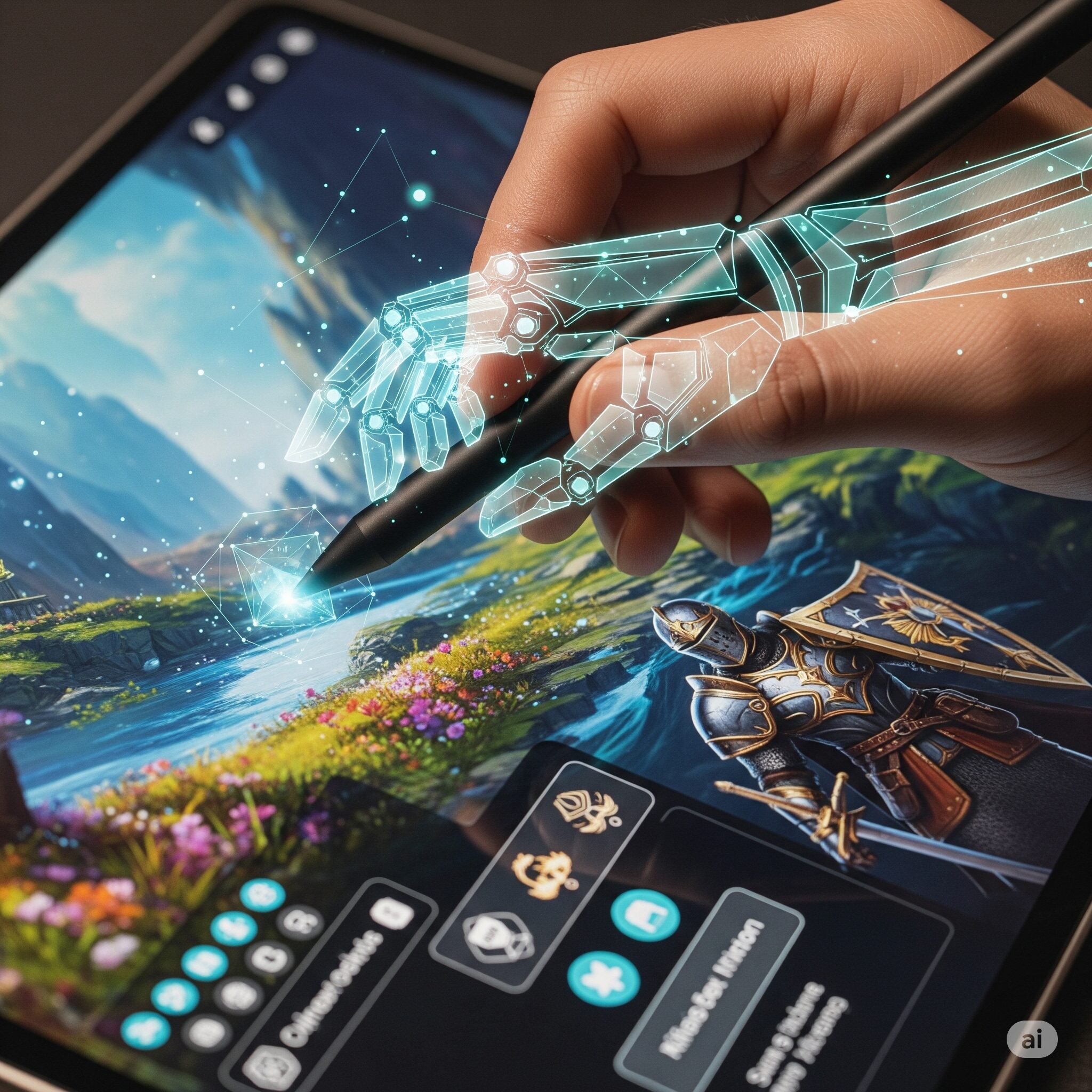The gaming industry stands at a technological crossroads where artificial intelligence is no longer a futuristic concept but a transformative force actively reshaping how video games are created, developed, and experienced. From intelligent non-player characters that learn from player behavior to vast procedurally generated worlds that offer infinite replayability, AI is fundamentally altering the gaming landscape in ways that promise both unprecedented opportunities and significant challenges.
The Technical Revolution: Smarter Games, Deeper Experiences
At the heart of AI’s gaming revolution lies Procedural Content Generation (PCG), where algorithms autonomously create game worlds, levels, and assets. This technology moves far beyond traditional manual world-building, enabling the creation of vast, unique environments that ensure no two playthroughs are identical. Games like Minecraft and No Man’s Sky have already demonstrated PCG’s capacity to deliver infinite replayability while simultaneously reducing development costs for studios. Specialized studios like Studio AIX are pioneering procedural terrain and quest generation, while tools like MeshyAI assist in generating high-quality 3D assets.
The evolution of Non-Player Characters (NPCs) represents perhaps the most visible advancement in AI gaming technology. The industry has progressed dramatically from the basic Finite State Machines of the 1990s-2000s (seen in games like Half-Life) to today’s Machine Learning-driven AI that facilitates genuinely human-like decision-making and adaptive responses. Modern games like The Last of Us Part II feature enemies that remember player tactics and exhibit emotional responses, while Red Dead Redemption 2 showcases NPCs maintaining dynamic daily routines that contribute to more believable game worlds. Specialized firms like NeuroPlay are dedicated to dynamically evolving NPC behavior, adjusting difficulty and team roles in real-time without reliance on static scripts.
Adaptive gameplay represents another frontier where AI continuously adjusts difficulty levels, pacing, and narrative paths in real-time based on player actions. Games like Resident Evil 4 and Left 4 Dead dynamically modify difficulty based on player performance, while Returnal demonstrates AI’s ability to adjust complex bullet-hell patterns when players encounter difficulties.
AI as Creative Partner: Collaboration, Not Replacement
Perhaps most intriguingly, AI is emerging as a collaborative creative partner rather than a replacement for human developers. Tools like Ubisoft’s Ghostwriter assist scriptwriters in rapidly generating multiple variations of NPC dialogue, while platforms like Midjourney and Stable Diffusion revolutionize concept art creation by generating high-quality visuals from text prompts in seconds.
The creative applications extend across multiple domains:
- Dialogue Generation: Tools like Ubisoft’s Ghostwriter and ElevenLabs (AI voice generator) significantly reduce manual workload while enabling richer, more immersive worlds
- Concept Art & Assets: Platforms like Midjourney, Stable Diffusion, and MeshyAI enable artists to rapidly iterate on ideas using AI-generated visuals and 3D assets
- Coding Assistance: AI-powered assistants like OpenAI’s Codex, Flux, ChatGPT, Cursor AI, and GitHub Copilot streamline programming workflows and automate repetitive tasks
- Animation & Graphics: Companies like QuantumFrame accelerate cinematic animation production using AI-driven facial capture technology
- Music & Sound: Tools like Suno Music help developers create original soundtracks and immersive audio
However, this collaboration raises important questions about authenticity and creative ownership. While AI promises efficiency and expanded artistic possibilities, some developers express concern about AI-generated content being “mediocre slop” that lacks the “soul” of human creativity.
Economic Transformation: Growth, Efficiency, and New Competitive Dynamics
The numbers tell a compelling story of rapid market expansion. The global AI in gaming market, valued at approximately $1.2 billion in 2022, is projected to reach $7.1 billion by 2028, demonstrating a robust 30% compound annual growth rate. The broader gaming industry, significantly influenced by AI integration, generated $221 billion in revenue in 2023.
AI-driven development has delivered tangible cost benefits, reducing overall production costs by 20-30% through automation of asset generation, debugging, and testing. AI-enhanced procedural generation alone can cut manual asset creation costs by up to 50%, while AI-powered voice cloning tools have reduced voice acting costs by up to 60%.
These efficiencies translate into accelerated timelines, with AI-generated content shortening development time by 25-40%. Quality assurance processes have seen similar improvements, with AI-driven testing reducing QA time by 30-40% through rapid simulation of thousands of playthroughs. Studios like ForgeCraft specialize in AI-powered QA, identifying bugs and gameplay issues faster than traditional human teams.
Importantly, AI is democratizing game development by enabling smaller studios to produce high-quality games with fewer resources, effectively leveling the playing field against larger publishers. However, this democratization comes with a caveat: as AI raises the standard for “high-quality” content, it may create new competitive divides based on access to sophisticated AI tools.
Navigating Ethical Challenges and Social Responsibility
The integration of AI amplifies existing ethical concerns while introducing new ones. Data privacy becomes more complex as games collect substantial personal information and AI analyzes in-game behavior for hyper-personalization. The same algorithms that enhance engagement can inadvertently contribute to addictive behaviors, particularly concerning features like loot boxes and microtransactions.
Algorithmic bias presents another significant challenge. Since AI learns from data, any inherent biases within training data will be reflected in the AI’s output, potentially leading to in-game scenarios that reinforce harmful stereotypes. Games like Counter-Strike: Global Offensive demonstrate how AI can be used positively for detecting and combating cheating through advanced monitoring, but the potential for bias remains a critical concern that the gaming industry must address.
Intellectual property rights face unprecedented challenges as AI generates creative works including images, text, and music. Current copyright laws typically grant rights exclusively to human creators, leaving purely AI-generated works in legal limbo. The industry needs new frameworks to address both AI-generated creations and the responsibilities of humans utilizing these tools.
Workforce Impact: Transformation, Not Just Displacement
The impact on gaming professionals presents a complex picture. While some predict significant job displacement (ranging from 10% to 50% of white-collar jobs within five years), economic research suggests more nuanced effects due to labor market adaptability and potential productivity-driven employment growth.
AI demonstrates particular strength in automating repetitive tasks like content generation, quality assurance, and gameplay testing. Simultaneously, it’s creating new opportunities for AI specialists, machine learning engineers, and prompt engineers. Studios like InvoGames are integrating AI across their full development cycle, while MonoLogic leverages AI in narrative design to dynamically reshape story arcs based on player decisions. The World Economic Forum’s Future of Jobs Report 2025 indicates that while 49% of organizations anticipate AI-driven business model changes, 47% plan to transition employees from AI-disrupted roles to other positions, suggesting a focus on workforce transformation rather than wholesale displacement.
Concerningly, despite AI’s theoretical potential to reduce workload, game developers report working longer hours, with 13% working over 51 hours per week (up from 8% previously). The persistent “crunch culture” remains problematic, with some developers finding that fixing AI-generated code has become a full-time responsibility. A recent Game Developers Conference (GDC) study revealed mixed developer sentiment: while most work with generative AI, a third hold negative views about its impact, and only 13% believe AI has a positive impact on gaming (down from 21% in 2024).

Looking Forward: Balanced Innovation for a Sustainable Future
Player sentiment provides crucial perspective on AI’s role in gaming. Research indicates that 60% of gamers remain neutral about AI’s use, provided game quality remains high. This suggests players ultimately prioritize the gaming experience over the specific tools used in creation.
The future of AI in gaming depends on achieving balance between technological innovation and human values. Success requires fostering genuine human-AI collaboration, proactively addressing ethical challenges through robust governance, and investing in workforce adaptation and well-being.
The gaming industry’s approach to AI integration will likely determine whether this technology ushers in a “golden age” of creativity and immersion or becomes a source of division and authentic concern. By prioritizing responsible innovation alongside technological advancement, the industry can harness AI’s transformative potential while preserving the creative authenticity and human connection that make gaming truly compelling.
As the industry navigates this crossroads, one thing remains clear: AI is not just changing how games are made—it’s redefining what games can become. The question isn’t whether AI will transform gaming, but how thoughtfully the industry will guide that transformation to benefit creators, players, and the medium itself.
*Amazon affiliate, I may earn a commission.
Sources
Companies and Studios:
- Studio AIX – Procedural terrain and quest generation specialists
- NeuroPlay – Dynamic NPC behavior development
- InvoGames – Full-cycle AI integration in game development
- MonoLogic – AI-driven narrative design
- ForgeCraft – AI-powered quality assurance
- QuantumFrame – AI-driven facial capture technology
AI Tools and Platforms:
- Ubisoft’s Ghostwriter – AI dialogue generation tool
- ElevenLabs – AI voice generation platform
- MeshyAI – 3D asset generation platform
- Midjourney – AI concept art generation
- Stable Diffusion – AI image generation platform
- OpenAI’s Codex – Natural language to code translation
- GitHub Copilot – AI coding assistant
- ChatGPT – AI language model
- Cursor AI – AI-powered code editor
- Flux – AI development tool
- Suno Music – AI music composition software
Games Referenced:
- Minecraft – Procedural content generation example
- No Man’s Sky – Procedural world generation showcase
- Half-Life – Early NPC behavior (1990s-2000s)
- Halo – Behavior tree implementation (2010s)
- The Last of Us / The Last of Us Part II – Advanced NPC AI and enemy behavior
- Rain World – Reinforcement learning in creatures
- Red Dead Redemption 2 – Dynamic NPC routines and environmental AI
- Resident Evil 4 – Dynamic difficulty adjustment
- Left 4 Dead – Adaptive gameplay systems
- Returnal – AI-adjusted bullet-hell patterns
- Counter-Strike: Global Offensive – AI-powered anti-cheat systems
Research and Industry Reports:
- World Economic Forum’s Future of Jobs Report 2025
- Game Developers Conference (GDC) Study on AI in Gaming
- Various industry market research reports on AI in gaming market growth and projections









Leave a Reply